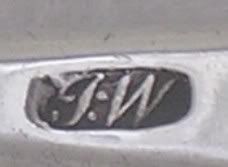I have to admit a certain confusion here.
Are we talking about
Thomas Wallis I or his apprentice
Thomas Wallis II? (I thought they were father & son, but aparently no blood relationship has been established).
The following information comes from
http://www.silversugartongs.com" onclick="window.open(this.href);return false;
"Thomas Wallis I registered his first mark on 8th March 1758 as a large-worker. He entered other marks in 1763 and was known to be working at least until 1771 when Thomas Wallis II was apprenticed to him. Curiously there is no evidence that the two were related. He was later registered as a Plate-worker. Thomas Wallis I died some time between 1818 and 1822."
"Thomas Wallis II registered his first mark on 7th November 1778 as a plate-worker. He had been apprenticed to Thomas Wallis I. ... Thomas Wallis II then entered four marks as a buckle-maker between 1780 and 1789 before entering another mark in 1791 as a plate-worker. He entered several more marks before going into partnership with Jonathan Hayne in 1810. Thomas Wallis II´s mark is a very distinctive script "TW" in a rectangular punch. Thomas Wallis II marks also very often have a journeyman's mark.
"Thomas Wallis II is often confused with John Wren II. Jackson's does not refer to Thomas Wallis II but shows a mark that looks very similar to Thomas Wallis's, attributing it to John Wren II with a question mark against it. Grimwade records John Wren II as a spoon-maker and his mark very clearly has a pellet between the I and the W and the I actually looks like an I. John Wren II was also earlier, his first mark was entered in 1777, and he was only known to be working until 1795."
In addition, this site has a page devoted to a year-by-year analysis of the script-style marks of Thomas Wallis II:
http://www.silversugartongs.com/london/ ... lis_II.htm" onclick="window.open(this.href);return false;
Assuming this is complete and accurate, Granmaa´s mark is not Wallis II. The far right stem of the W does not curl over.
So, is this spoon by Wallis I?
Here I must confess a lack of reference. By the late 1760s Wallis I seems to have used TW in Roman capitals as his mark, remaining with this style throughout the rest of his career. So do we definatively know what Wallis I's earlier mark looked like? As several different silversmiths possibly used very similar marks - compounded by the close similarity of the letters I, J and T when in script - can we be completely sure that errors have not crept into the litterature or been made by dealers in their attributions?
.





